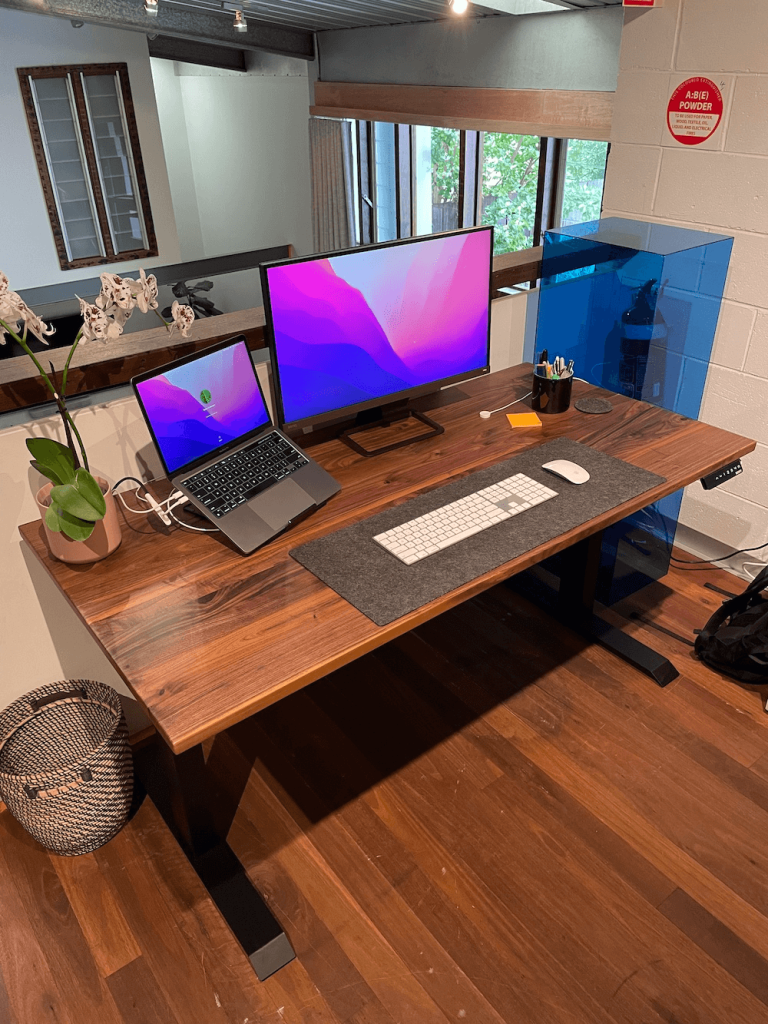Phone:
(701)814-6992
Physical address:
6296 Donnelly Plaza
Ratkeville, Bahamas.

Last Updated on:
Sitting for long periods has been known to trigger neck pain, lower back pain, and obesity, causing people to gain excess fat and increased blood sugar levels. All these can affect your work efficiency and quality of life. That is why individuals have begun integrating standing desks into their routine to promote overall well-being and boost productivity at work, enabling workers to make standing their default stance. Here is a complete guide on standing desk pros and cons and our recommendations on how to maximize their benefits and minimize the associated risks.
Let’s get started!

A standing desk is also called a sit-stand and stand-up desk. Its primary function is to encourage movement and blood circulation in working people by allowing them to stand throughout the day.
Compared to a regular desk that promotes prolonged sitting, a standing desk offers users better posture and ergonomics.
It reduces stress levels and body pains and prevents musculoskeletal and cardiovascular disease.
However, it also has disadvantages, especially if you’re unaware of the tips and tricks for maximizing the benefits and minimizing the risks of a standing desk.
These cons include foot pain, muscle fatigue, varicose veins, and poor posture caused by prolonged periods of inappropriate standing.
To help you understand standing desks better, read more about the pros and cons in this section!
As mentioned, standing desks encourage good posture, improved focus and work productivity, and other health benefits.
These positives, which we further elaborate on, contribute to the increasing popularity of the standing desk among office workers, work-from-home employees in hybrid work situations, and even students.
In our observation, the first thing that comes to mind when discussing standing desks is their long-term health benefits.
When a standing desk is used correctly in conjunction with a balanced diet and exercise, the following health perks become attainable.
Research shows that out of the sample population, those with standing desks, or 31.8% of participants, experienced less back pain or musculoskeletal discomfort.
Evidence also showed that reducing prolonged sitting by integrating standing workstations helps ease around 54% of upper back and neck pain.
You can also incorporate more physical activity (exercises and stretches) in a standing workstation than in one designed for sitting.
This enables users to experience faster metabolism, effective calorie burning, and efficient blood flow, decreasing the risks of heart problems.
Users even experience 174 more calories burned when balancing sitting and standing throughout their eight hours of work instead of contributing to the sitting epidemic.
Another advantage of using standing desks is that it helps boost productivity and focus.
Since you can move around, do some stretches, and get the endorphins running into your system while standing, you get to keep your mind focused and sharp.
This, in turn, helps you achieve better results in writing, planning creative ideas, and other work-related tasks.
The physical activity that comes with a sit-and-stand desk helps an office worker achieve higher efficiency of about 45%, compared to a worker who sits on an office chair throughout the day.
As workers accustomed to regular desks, we often have bad posture from a long period of sitting and improper ergonomics at our workstation that normalizes slouching, hunching, resting on one side, and other unsavory positions.
With standing desks and proper ergonomics, you can alternate between sitting and standing throughout the day, observe proper posture, and boost core strength.
Here’s how to get a better posture with standing desks:
Knowing the standing desk pros is insufficient when making a sound buying decision. It’s equally essential to understand the cons of standing desks before getting one.
Some cons of standing desks are sore feet and leg muscles, joint damage, fatigue, and a worse stance than what you had before shifting.
These become more prevalent when you do not observe proper ergonomics, stances, and standing durations when using office furniture (office chair, desk, monitor, etc.).
Learn more about what these cons of standing desks entail and the benefits of using a standing desk mat.
Prolonged standing causes a buildup of fluid in the leg veins, which results in the soreness of the leg muscles and even sore feet, much like what you get when sitting.
This buildup restrains the proper flow of blood in the legs and feet, which causes throbbing pain from swelling and soreness. It can even cause varicose veins.
When people stand for prolonged periods, the feet, hips, spine, and knees also become numb, resulting in further joint damage.
Aside from standing for countless hours in the office, here are other factors that can lead to this type of joint damage:
Using a standing desk for a full day with little to no sitting can restrict blood flow, particularly in the legs and feet.
With improper blood flow, adverse health conditions can arise, such as muscle discomfort, knee and foot strains, and increased fatigue.
Two types of fatigue are experienced by workers when using standing desks for unreasonable hours, and these are psychological and muscle fatigue.
On the one hand, psychological fatigue increases feelings of emotional and mental exhaustion, decreasing the performance level of workers. On the other, muscle fatigue lowers the force of muscles, affecting energy and other abilities.
An anti-fatigue mat can help manage fatigue symptoms, as it brings comfort and better blood and oxygen circulation in your body.
The inappropriate use of many standing desks leads to similar cons as a sedentary lifestyle since both affect your stances and postures.
Standing with an improper desk height can cause slouching due to low or high monitor levels. You also put all your weight on one side, disregarding your core and making yourself prone to poor body stances.
As you keep your body standing for a full day, you will most likely acquire long-term detrimental effects to your physical, emotional, and mental health.
The good thing is that you can experience standing desk pros without exposing yourself to the cons by observing the recommended duration for standing at a standing desk.
This means 15 minutes of standing every 30 to 45 minutes of sitting.
While standing, you can do effective exercises for standing desk users, which we will also introduce in this section.
While undergoing the standard stand time, you can toss in some standing exercises and take breaks to prevent exhausting your neck, shoulders, and back. This will help you burn more calories.
Here are some of the body stretches and exercises you can do:
You can also move your body by walking around the office, cleaning office furniture, sorting out your desk, or talking with colleagues.
Aside from taking regular breaks, you NEED to remember the guidelines for standing desk use to attain its health advantages. Here are a few:
Some of us have asked the question: are standing desks overrated?
If you think so, you can opt for standing desk alternatives, such as investing in the adjustable type rather than the fixed desk or integrating regular breaks and movement.
Let us give you more options by explaining the alternatives in this section!
One of the best types of a standing desk is the adjustable desk for the following reasons:
We said earlier that breaks and movement are essential when your job requires sitting for long hours to stretch the muscles and prevent health issues.
To reiterate, you can work out, stretch your body, walk around the office, and eat out during your lunch break. Talk with others, find a hobby to squeeze in during breaks, and do other things that can keep you happy and healthy.
Before investing in a standing desk, consider the pros and cons, your workspace requirements, budget, personal health, and comfort. These will help you in finding the best standing desk for your needs.
It is also best to try understanding different standing desk mechanisms before investing in one.
So, get to know what these factors mean in this section!
The most crucial factor to consider when investing in a standing desk is determining your workspace’s requirements, as some workspaces have limited desk space or cubicle areas.
Aside from determining the width, you may need more vertical space to accommodate standing desks, especially those with a higher maximum height capacity.
You also need to assess the style of your office and your current space before buying a standing desk. Buying an L-shaped standing workstation would be a waste of money if your space cannot cater to it.
Choose a standing desk that’s within your financial capacity. There are standing desks that are affordable but cost-efficient. They’ll have a better design, height adjustments, and other vital features.
Also, remember that a high price does not always mean a better product. It would still depend on its functionality and ease of use.
It is a no-brainer to choose desks that will help you achieve a better state in terms of your health and comfort.
Although ergonomic in nature, many standing desks (overrated in the opinion of some) actually do more harm than good, particularly when it does not fit your height and don’t allow you to move freely.
Sitting and standing are normal parts of our lives but are impactful enough to change the course of our health. In understanding the pros and cons of a sit-stand desk, it’s essential to find the answers to your FAQs!
Yes, sit-stand desks are better than sitting desks as the former gives individuals a chance to do physical activities, lessen lower back and neck pains, and increase productivity.
You should stand at a standing desk for 15 minutes every 30 to 45 minutes of sitting.
No, you cannot use a standing desk all day because it can result in sore feet, sore leg muscles, joint damage, fatigue, and poor posture.
Yes, it is possible to lose weight using this type of desk because you can do light exercises and stretch while standing.
You can choose the right standing desk by considering your workspace requirements, budget, personal health, and comfort.
A sit-stand desk helps improve your body stance and work productivity and produces other health benefits. However, inappropriate use of it can lead to the soreness of muscles, joint damage, fatigue, and poor postures.
The best way moving forward is to invest in a suitable desk that perfectly complements your work, height, and comfort. It should help you find the right balance between sitting and standing.
Now that you know the standing desk pros and cons, the best thing to do is scout for the best one and start your healthy working life!